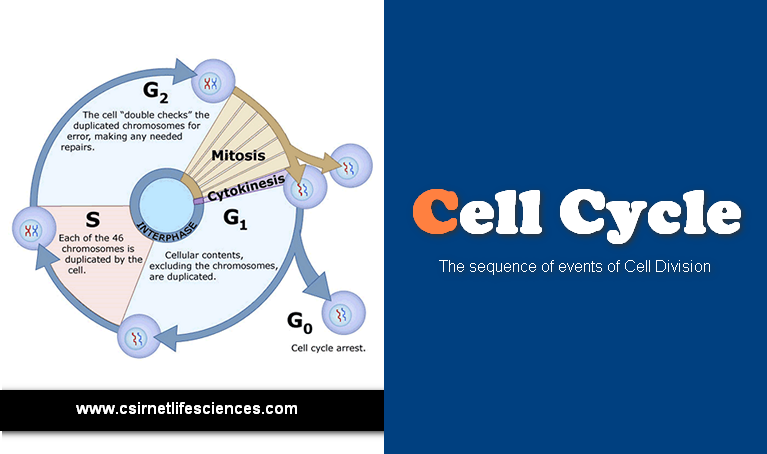
What is Cell Cycle ? The sequence of events which occurs between one cell division and the next is called the Cell cycle. The cell cycle comprises the period between the release of a cell as one of the progeny of a division and its own subsequent division into two daughter cells.
Stages of Cell Cycle:
It has three main stages.
1. Interphase :
This is a period of synthesis and growth. the cell produces many materials required for its own growth and for carrying out all its functions. DNA replication occurs during interphase.
2. Mitosis :
This is the process of nuclear division.
3. Cell Division :
This is the process of division of the cytoplasm into two daughter cells.
The length of the cell cycle depends on the type of cell and external factors such as temperature, food and oxygen supplies. Bacteria may divide every 20 minutes, Epithelial cells of the intestine wall every 8 to 10 hours, Onion root tips cells may take 20 hours whilst many cells of the Nervous system (neurons) never divide.
Cell division and cell growth :
In living cells a continuous transport of nutrients, signal molecules and degradation products occurs between the nucleus and the cytoplasm and between various compartments of the cytoplasm. Such transport is mainly realized by passive diffusion, but also targeted transport occurs along membranes and cytoskeleton elements.
In the case cells would endlessly continue to grow, the distance and complexity of transport would become an hampering for the optimal functioning of the cell. Cell division has arisen in the course of evolution as a solution to this problem.
Cellular proliferation like it occurs during the development of organisms, but also in malignant tissue expansion, is based on an alternation of division and growth phases (here schematically illustrated for one cell; D for division and Gr for growth).
Within a single cell cycle two main phases can be distinguished:
- The M phase which is characterized by the actual chromosomal and cellular division (mitosis or meiosis) and
- the M phase which is the interpahse between to two subsequent divisions.
During the interphase the cell caries out its main tasks and gets prepared for the next division. The interphase comprises a G1, S and G2 phase. More here about in the table here below…
Phases of the cell cycle :
Mitotic division: M- and C-phase :
In the proper Mitosis Cell Division phase (M-phase of mitosis) a daughter cell identical to the mother cell is produced. The envelop around the nucleus disappears at the beginning of mitosis and the -duplicated- genetic material is divided equally over the two daughter nuclei. Mitotic division is concluded in a single round. During cytokinesis (C-phase) the cytosol and the organelles are divided over the daughter cells. The cytokinesis is sometimes regarded as part of mitosis.
Interphase: G1-, S- and G2-phase :
During interphase most cell growth and nuclear activities take place. Interphase consists of the G1-phase (G from gap), the S-phase (S= synthesis) and the G2-phase.
The G1-phase covers the period between mitosis and DNA replication. In this phase cytoplasmic growth occurs and the cell is preparing its enzymatic machinery to be ready for the next stage (synthesis); The daughter cells become as large as the mother cell. the chromosomes are thread-like and invisible. The duration of the cell cycle is preponderantly determined by the extend of the G1-phase. Cells in a rapidly developing tissue have thus a short G-1 phase.
The S-phase is the period during which DNA replication (synthesis) takes place, thus, duplication of the genome.
The G2-phase is the period between DNA replication and mitosis. During this lapse rapid control of the replicated DNA is performed and the proper division is prepared.
Exit-phase: G0-phase and meiosis :
Cells can leave the mitotic cell cycle (cessation of periodic cell division) at the G1 to transit to the following two conditions. In the first place such cells can enter in a non-dividing state (a relative “quiescence” or “rest” phase), the so-called G0 phase, in which a variable level of differentiation occurs. Distinction can be made between cells that keep the ability (potency) to further differentiate and cells that have accomplished and finished differentiation (for example muscle and nerve cells). Some other cells can further develop to reproduction cells by entering meiosis. This special type of division, that then replaces mitosis in the cell cycle, is fundamental for introducing genetically variation over generations and in a population.
